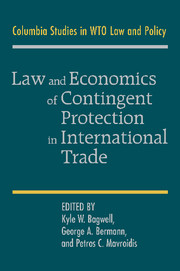Book contents
- Frontmatter
- Contents
- Contributors
- Introduction
- 1 An Overview of the Agreement on Subsidies and Countervailing Measures – Including a Discussion of the Agreement on Agriculture
- 2 Do the World Trade Organization Disciplines on Domestic Subsidies Make Sense? The Case for Legalizing Some Subsidies
- 3 Subsidies and Countervailing Measures: Determining the Benefit of Subsidies
- 4 The Enduring Problem of World Trade Organization Export Subsidies Rules
- 5 The Boeing–Airbus Dispute: A Case for the Application of the European Community State Aid Rules?
- 6 Antidumping: Overview of the Agreement
- 7 Price Differentiation in Antitrust and Trade Instruments
- 8 Nonpreferential Origin Rules in Antidumping Law and Practice
- 9 The Appellate Body Interpretation of “Sunset Reviews” Provisions of Anti-Dumping and Countervailing Measures Agreements: A Critical Analysis
- 10 The Safeguards Agreement – An Overview
- 11 Why Are Safeguards Needed in a Trade Agreement?
- Index
- References
1 - An Overview of the Agreement on Subsidies and Countervailing Measures – Including a Discussion of the Agreement on Agriculture
Published online by Cambridge University Press: 03 May 2010
- Frontmatter
- Contents
- Contributors
- Introduction
- 1 An Overview of the Agreement on Subsidies and Countervailing Measures – Including a Discussion of the Agreement on Agriculture
- 2 Do the World Trade Organization Disciplines on Domestic Subsidies Make Sense? The Case for Legalizing Some Subsidies
- 3 Subsidies and Countervailing Measures: Determining the Benefit of Subsidies
- 4 The Enduring Problem of World Trade Organization Export Subsidies Rules
- 5 The Boeing–Airbus Dispute: A Case for the Application of the European Community State Aid Rules?
- 6 Antidumping: Overview of the Agreement
- 7 Price Differentiation in Antitrust and Trade Instruments
- 8 Nonpreferential Origin Rules in Antidumping Law and Practice
- 9 The Appellate Body Interpretation of “Sunset Reviews” Provisions of Anti-Dumping and Countervailing Measures Agreements: A Critical Analysis
- 10 The Safeguards Agreement – An Overview
- 11 Why Are Safeguards Needed in a Trade Agreement?
- Index
- References
Summary
Introduction
The present contribution aims to provide an insight into the World Trade Organization's (WTO's) multilateral disciplines on subsidies related to trade in goods and on unilateral measures to respond to these subsidies, in other words, countervailing duties (CVDs). In our discussion, we focus on the legal analysis and thus leave the economic analysis to other contributions in this book. As such, we offer only one part of the introduction to the Agreement on Subsidies and Countervailing Measures (“SCM Agreement”), which should be complemented with the economic analysis to evaluate the subsidy and CVD disciplines from a normative point of view.
Our legal analysis is structured around six parts. After a short overview of the legal and historical context, we clarify the object and purpose of the SCM Agreement and examine the various aspects of the definition of “a subsidy” included in the SCM Agreement. When a specific subsidy is deemed to exist under the SCM Agreement, a traffic light metaphor can be made when categorizing subsidies. Some types of subsidies are prohibited (red light), whereas all other specific subsidies are allowed as long as they do not cause adverse effects (yellow light). At present, no type of subsidy gets the green light under the SCM Agreement. Later in this chapter, we look at how WTO Members may respond to subsidies provided by other WTO Members.
- Type
- Chapter
- Information
- Publisher: Cambridge University PressPrint publication year: 2009
References
- 3
- Cited by



